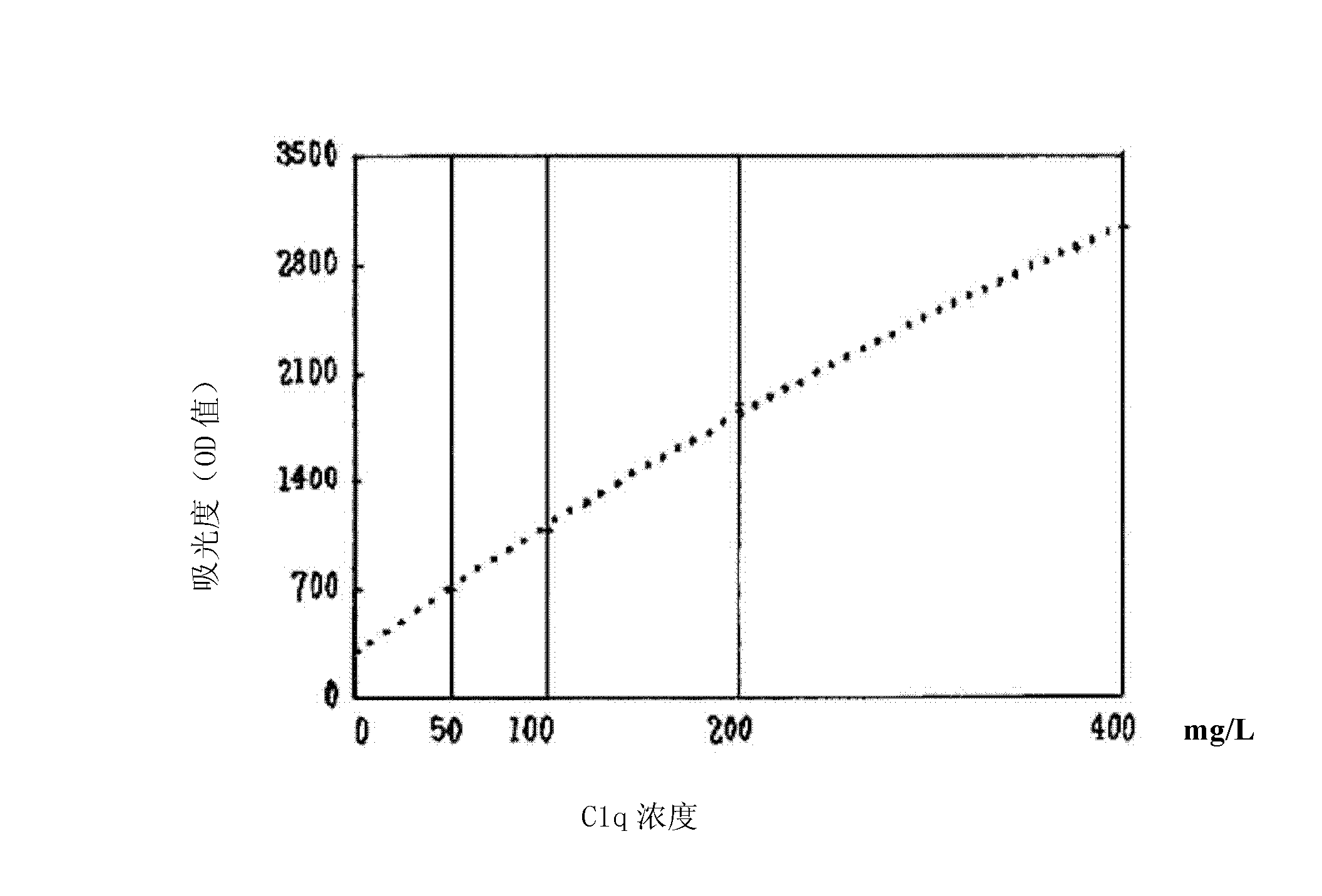Kit and method for detecting concentration of complement Clq in human serum
A technology for detecting people and kits, which is applied in the field of bioengineering, can solve the problems of complex Clq concentration process and low accuracy, and achieve the effect of significant technological progress, high accuracy, and simple and convenient process
- Summary
- Abstract
- Description
- Claims
- Application Information
AI Technical Summary
Problems solved by technology
Method used
Image
Examples
Embodiment 1
[0016] 1.1 Kit specification
[0017]
[0018] 1.2 Components
[0019] R 1 : Disodium hydrogen phosphate 28.6g / L Potassium dihydrogen phosphate 2.7g / L
[0020] PEG6000 50g / L EDTA-NA 2 1g / L
[0021] TX-100 0.2ml / L
[0022] R 2 : Disodium hydrogen phosphate 28.6g / L Potassium dihydrogen phosphate 2.7g / L
[0023] PEG6000 50g / L EDTA-NA 2 1g / L
[0024] TX-100 0.2ml / L rabbit anti-human complement Clq antiserum 300ml / L
[0025] 1.3 Applicable instruments
[0026] Semi-automatic and fully automatic biochemical analyzers.
[0027] 1.4 Analytical method
[0028] Immunoturbidimetry.
[0029] 1.5 Sample Requirements
[0030] Use human serum, store at 2-8°C, test within 24 hours, if it cannot be tested within 24 hours, store at -20°C for 4 months, hemolysis and severe lipemia (such as chylus) samples cannot be used.
[0031] 1.6 Performance requirements
[0032] 1.6.1 Reagent Appearance
[0033] R1: colorless clear transparent liquid;
[0034]...
Embodiment 2
[0050] Example 2 Experimental method
[0051] 2.1 Detection conditions
[0052] 2.1.1 Biochemical analyzer (hereinafter referred to as instrument)
[0053] Hitachi 7060 automatic biochemical analyzer.
[0054] 2.1.2 Working environment temperature
[0055] Room temperature 15-32°C.
[0056] Indoor humidity 45-85% RH.
[0057] 2.1.3 Main measurement parameters and operation steps
[0058] Temperature 37°C; main wavelength 340nm (secondary wavelength 700nm), sample or calibrator 4μl; R 1 : 240 μl; R 2 : 60 μl, reaction time 10 minutes.
[0059] Method type: two-point endpoint method.
[0060] After adding reagent R1 to the sample or calibrator, incubate at 37°C for 5 minutes, read the first point (A1), add reagent R2, incubate at 37°C for 5 minutes, and read the second point (A2), sample A=A2-A1.
[0061] Result calculation:
[0062]
[0063] 2.1.4 Calibrator
[0064] The calibrator used in this standard is the standard product produced by Nanfang Reagent Factory i...
Embodiment 3
[0103] The preparation of embodiment 3 reagents
[0104] Take a sample with a content of about 200mg / L, which is sample 4 # , the sample 4 # Prepare 5 test samples with physiological saline or pure water according to the method in the table below. (This sample is ready for use now)
[0105] 1 #
2 #
3 #
4 #
5 #
calibrator
-
4μl
2μl
4μl
8μl
normal saline
4μl
12μl
-
-
-
Sample volume after dilution
-
4μl
-
-
-
Concentration (mg / L)
0
50
100
200
400
[0106] After adding reagent R1 to the sample or calibrator, incubate at 37°C for 5 minutes, read the first point (A1), add reagent R2, incubate at 37°C for 5 minutes, and read the second point (A2), sample A=A2-A1.
[0107] Result instrument calculation:
[0108]
[0109] Through the determination of the above samples, the figure 1 Dose-response curves...
PUM
| Property | Measurement | Unit |
|---|---|---|
| absorbance | aaaaa | aaaaa |
Abstract
Description
Claims
Application Information
 Login to View More
Login to View More - R&D
- Intellectual Property
- Life Sciences
- Materials
- Tech Scout
- Unparalleled Data Quality
- Higher Quality Content
- 60% Fewer Hallucinations
Browse by: Latest US Patents, China's latest patents, Technical Efficacy Thesaurus, Application Domain, Technology Topic, Popular Technical Reports.
© 2025 PatSnap. All rights reserved.Legal|Privacy policy|Modern Slavery Act Transparency Statement|Sitemap|About US| Contact US: help@patsnap.com



